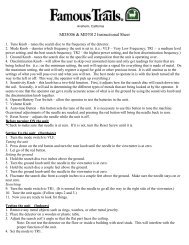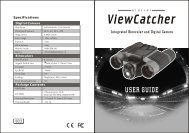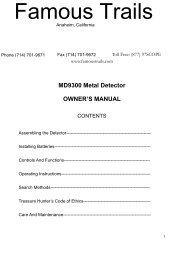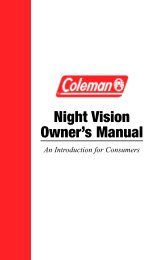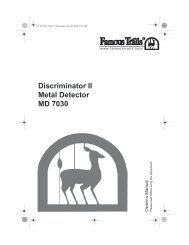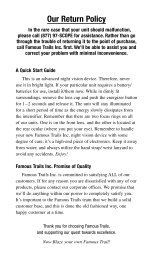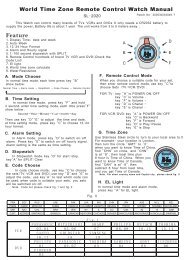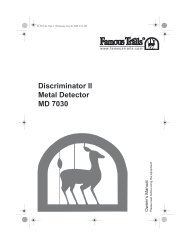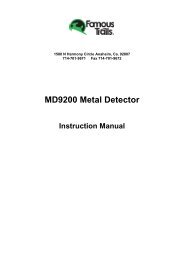GC-1010 Metal Detector - Radio Shack
GC-1010 Metal Detector - Radio Shack
GC-1010 Metal Detector - Radio Shack
You also want an ePaper? Increase the reach of your titles
YUMPU automatically turns print PDFs into web optimized ePapers that Google loves.
Famous Trails<br />
Anaheim, California<br />
Phone (714) 701-9671 Fax (714) 701-9672 Toll Free: (877) 97SCOPE<br />
www.famoustrails.com<br />
MD9100 <strong>Metal</strong> <strong>Detector</strong><br />
OWNER’S MANUAL<br />
1
CONTENTS<br />
Features……………………………………………………………………... 3<br />
Preparation………………………………………………………………….. 4<br />
Assembling the detector………………………………………………… 4<br />
Installing the batteries…………………………………………………… 5<br />
Using headphones……………………………………………………….. 5<br />
Listening safely…………………………………………………………… 6<br />
Functions and indications………………………………………………….. 6<br />
A quick look at the detector……………………………………………… 6<br />
Displays…………………………………………………………………… 6<br />
Tones……………………………………………………………………… 8<br />
Operation……………………………………………………………………. 9<br />
Turning on the detector………………………………………………… 9<br />
Setting the operation mode……………………………………………… 9<br />
Testing and using the detector………………………………………….. 10<br />
Indoor testing and use………………………………………………… 10<br />
Outdoor testing and use………………………………………………. 11<br />
Search coil sweeping hints………………………………………………. 12<br />
Adjusting sensitivity……………………………………………………… 13<br />
Application Hints……………………………………………………………. 13<br />
Pinpointing the target……………………………………………………. 13<br />
Factors that affect the detecting………………………………………… 14<br />
Care, maintenance and warranty………………………………………... 14<br />
2
Features<br />
With your metal detector, you can hunt for coins, relics, jewelry, gold, and silver<br />
just about anywhere. The detector is versatile and easy to use.<br />
The detector’s features include:<br />
LCD Display—shows the probable type of metal with an arrow, the depth of<br />
the target, DISC/NOTCH range, the level of sensitivity, the operating mode, and<br />
low battery indication.<br />
Three Tone Audio Discrimination—sounds distinctive tones for different<br />
types of metals.<br />
Notch—ignores junk metal and finds valuable items by setting the disc and<br />
notch range.<br />
Super Slow Sweep Identification—with a very slow sweep of the search coil<br />
to discriminate different types of metal.<br />
Headphone Jack—lets you connect headphones (not supplied) and operate<br />
without trouble.<br />
Waterproof Search coil—lets you use the detector even if you must put it<br />
under water.<br />
Note: Your metal detector requires two 9-volt alkaline batteries (not supplied).<br />
3
PREPARATION<br />
ASSEMBLING THE DETECTOR<br />
Assembling your detector is easy and requires no special tools. Just follow<br />
these steps.<br />
1. Turn the stem’s lock nut clockwise until it loosens.<br />
2. Lengthen or shorten stem so that when you stand upright with the detector in<br />
your hand, the search coil is level with and about 1/2 to 2 inches above the<br />
ground with your arm relaxed at your side.<br />
3. Turn the stem’s lock nut counter-clockwise to lock it in place.<br />
4. Unscrew the knob on the search coil and remove the knob connector. Insert<br />
the stem and align the holes on the search coil bracket and the stem. Push<br />
the connector through the holes and tighten the knob.<br />
5. Wind the search coil cable around the stem. Leave enough slack in the<br />
cable.<br />
6. Insert the search coil’s plug into the search coil jack on the detector’s control<br />
housing.<br />
Caution:<br />
• The search coil’s plug fits into the connector only one-way. Do not force<br />
the plug or you could damage it.<br />
SEARCHCOIL<br />
KNOB CONNECTOR<br />
STEM<br />
LOCK NUT<br />
CABLE<br />
ARM SUPPORT<br />
4
7. Loosen the knob at the search coil’s end, then adjust the search coil to the<br />
desired angle so that it is parallel with the ground. Then tighten the knob.<br />
Caution:<br />
Do not over-tighten the search coil or use tools such as pliers to tighten it.<br />
8. Insert the arm support into the end of the stem and tighten the lock screw.<br />
INSTALLING THE BATTERIES<br />
Cautions:<br />
• Use only fresh alkaline batteries of required size.<br />
• Do not mix the old and new batteries or different types of batteries.<br />
1. Slide the POWER button to turn on the power.<br />
2. Slide the left battery cover off in the direction of the arrow.<br />
3. Place a 9V battery into the battery compartment matching the polarity<br />
symbols (+ and -) marked inside.<br />
Warning:<br />
• Dispose of old batteries promptly and properly. Never bury or burn them.<br />
Caution:<br />
• If you don’t plan to use the unit for a week or more at a time, remove the<br />
batteries. Batteries can leak chemicals that can destroy electronic parts.<br />
• To extend the battery life, exchange the left and right battery after<br />
3~4hours of operation.<br />
USING HEADPHONES<br />
1. Insert the headphones’ 3.5mm plug into the HEADPHONE jack. At this<br />
5
time the internal speaker disconnects.<br />
2. Set the VOLUME to the desired setting.<br />
headphone<br />
Listening Safely<br />
• To protect your hearing, set the volume to the lowest setting before you<br />
begin listening, adjust the volume to a comfortable level.<br />
• Do not listen at extremely high volume levels. Extended high volume<br />
listening can lead to permanent hearing loss.<br />
• Do not wear headphones while operating your detector near high-traffic<br />
areas. Pay attention to traffic safety.<br />
FUNCTIONS AND INDICATIONS<br />
1. A QUICK LOOK AT THE DETECTOR<br />
6
TARGET INDICATOR<br />
LCD SCREEN<br />
INDICATION PANEL<br />
VOLUME CONTROL<br />
FUNCTION PANEL<br />
OPERATION MODE<br />
BUTTONS<br />
UP & DOWN<br />
SENSITIVITY<br />
DISC/NOTCH<br />
POWER<br />
2. DISPLAYS<br />
The target indicator includes target icons and LCD displays and is located at<br />
the top of the detector. It can indicate different types of coins, gold, silver, etc.<br />
When the detector detects an object, an arrow appears below the target icon<br />
of the probable type of metal being detected and also displays the depth of<br />
the target. If the detector receives a strong signal, the arrow appears steadily.<br />
If the signal is weak, the arrow blinks or does not appear.<br />
Note:<br />
• If the detecting pauses for about 5 seconds, the arrow will disappear.<br />
• If an arrow points to a coin denomination, the detector might be<br />
detecting either a coin or another type of metal (such as jewelry, tokens,<br />
medals, or even junk metal) about the same size and type as the coin.<br />
• Since the indications are approximations, the detector might not have<br />
actually found the item it indicates. The indicator is only a visual<br />
reference to help you decide if an item is worth investigating.<br />
7
METAL ICONS<br />
TARGET INDICATION<br />
SENSITIVITY LEVEL<br />
LOW BATT<br />
DISC/NOTCH RANGE<br />
DEPTH<br />
OPERATION MODE<br />
BUTTONS<br />
SENSITIVITY DISC/NOTCH<br />
CONTROL INDICATION<br />
GOLD Range<br />
IRON FOIL—indicates that the target is probably iron or foil. Some oxidized<br />
iron might register somewhere within the SILVER range.<br />
5¢(NICKEL)—indicates that the target is probably a nickel.<br />
PULL TAB—indicates that the target is probably a pull-tab from an aluminum<br />
can. Some rough gold items might register within the PULL TAB category.<br />
S-CAPS—indicates that the target is probably a type of metal like a bottle cap<br />
with whorl. Some small gold items might register within this category.<br />
1¢—indicates that the target might be a zinc penny or a copper coin. Some<br />
large gold items might register within 1¢ category.<br />
SILVER Range<br />
1¢ 25¢--indicates that the target is probably 25¢ or 1¢. Some large aluminum<br />
cans might register within the 1¢ 25¢ category.<br />
TONES<br />
If the detector is set to the ALL METAL target mode, it sounds a single<br />
tone when it detects any type of metal. If you set the detector to the<br />
DISC or NOTCH modes, the built in audio identification system sounds<br />
a unique audio tone for each of three categories of metal. This makes it<br />
easier to identify the metal being detected. The detector sounds a low<br />
tone when it detects small gold items, nails, bottle caps or nickels, a<br />
medium tone for aluminum pull-tabs, zinc or copper items, and a high<br />
8
tone for brass or silver items.<br />
Note:<br />
• When you set the detector to DISC or NOTCH mode, the detector<br />
sounds a medium or high tone when it detects highly oxidized iron.<br />
An arrow appears in medium or high tone area.<br />
• Depending on the alloys used to make them, about 15 percent of<br />
gold rings cause the detector to sound a medium tone.<br />
•<br />
LOW TONE<br />
MEDIUM TONE<br />
OPERATION<br />
TURNING ON THE DETECTOR<br />
Slide the power switch to ON. The unit displays all symbols on the<br />
LCD screen. The detector sounds low, medium, and high tones,<br />
respectively. After about 2 seconds the detector enters stand-by state.<br />
At this time the LCD displays ALL METAL and SENS. The value of<br />
SENS on the segment is 5. The range from MIN. to MAX. for<br />
DISC/NOTCH is available.<br />
SETTING THE OPERATING MODE<br />
The detector comes with three operating modes of ALL METAL, DISC,<br />
and NOTCH. You can select the desired mode by the relative touch<br />
key.<br />
ALL METAL—used for detecting any type of metal. When the detector<br />
detects any type of metal, it sounds a tone.<br />
9
Note: When you operate in this mode, only SENS. control will function,<br />
DISC. Or NOTCH controls will not. To adjust the sensitivity, first press<br />
SENS and UP to increase the sensitivity, then press Dn to decrease it.<br />
a. DISC—used for target discrimination. You can set the target range<br />
from MAX to MIN by pressing DISC/NOTCH and UP & Dn keys. The<br />
detector can detect the metal type indicated on the display.<br />
Meanwhile the detector rejects other metal types by not displaying<br />
them on the screen. For example, press Dn key, 4 levels on segment<br />
from Max to Min and discrimination is increased. At this time, the<br />
detector can detect S- CAPS, 1¢ and also 25¢, while other types of<br />
metal are rejected.<br />
b. NOTCH—to ignore the metal type you do not want. You can select<br />
the metal type desired by pressing the UP and Dn keys. The LCD<br />
segment will indicate the selected types of metal. The detector can<br />
detect the selected metal type.<br />
TESTING AND USING THE DETECTOR<br />
To learn how the detector reacts to different metals, you should test it<br />
before you use it the first time. You can test the detector indoors and<br />
outdoors.<br />
Indoor Testing and Use<br />
1. Slide POWER to ON<br />
2. Set the operating mode.<br />
3. Place the detector on a wooden or plastic table, then remove any<br />
watches, rings, or metal jewelry you are wearing.<br />
4. Adjust the search coil so the flat part points towards the ceiling.<br />
Note:<br />
Never test the detector on a floor inside a building. Most buildings have<br />
10
metal of some kind in the floor, which might interfere with the objects<br />
you’re testing or mask the signal completely.<br />
5. Slowly sweep a sample of the material you want the detector to find<br />
(such as a gold ring or a coin) 2-3 inches or more above the face of<br />
the search coil. When the detector detects any metal, it sounds a<br />
tone and an arrow appears below the target icon. Also the LCD<br />
displays the depth of the target.<br />
Note:<br />
If you are using a coin, the detector will detect it more easily if you hold<br />
it so a flat side is parallel with the flat side of the search coil. A sweep<br />
with the side of a coin over the search coil might cause false indication<br />
and an unstable display of the arrow.<br />
Outdoor Testing and Use<br />
1. Slide POWER to ON. Set the operating mode.<br />
2. Find an area on the ground outside where there is no metal.<br />
3. Place a sample of the material you want the detector to find (such<br />
as a gold ring or a coin) on the ground.<br />
Note:<br />
If you are using valuable metal such as gold to test the detector, mark<br />
the area where you place the item, to help you find it later. (Do not place<br />
it in tall grass or weeds).<br />
4. Hold the search coil level to the ground about 1~2 inches above the<br />
surface, slowly move the search coil over the area where you<br />
placed the sample, sweeping the search coil in a side-to-side<br />
11
motion.<br />
Search coil Sweeping Hints<br />
• Never sweep the search coil as if it were a pendulum. Raising the<br />
search coil while sweeping will cause false readings.<br />
• correct<br />
wrong<br />
• Sweep slowly. Hurrying will cause you to miss targets.<br />
• Sweep the search coil from side to side in an arc line of 3 inches of<br />
motion and keep the search coil parallel with the ground.<br />
If the detector detects the item, it sounds a tone and an arrow and<br />
the depth appear on the display below the target icon.<br />
If the detector does not detect the item, make sure that the target<br />
mode is set correctly for the type of metal you’re searching for. Also<br />
make sure that you’re moving the search coil correctly.<br />
Note:<br />
• The detector responds with a signal when it detects most<br />
valuable metal objects. If a signal does not repeat after you<br />
12
sweep the search coil over the target a few times, the target is<br />
probably junk metal.<br />
• False signals can be caused by trash-filled ground, electrical<br />
interference, or large irregular pieces of junk metal.<br />
• False signals are usually broken or non-repeatable.<br />
Adjusting SENSITIVITY<br />
After you become familiar with how your detector works, it’s<br />
important to fine-tune the sensitivity to get a good effect. Press the<br />
touch button SENS on the panel. Then press UP or Dn to increase<br />
or decrease the sensitivity. The level on the segment will be<br />
displayed from high to low position.<br />
Note:<br />
In order to detect a target deeply buried, you can adjust the SENS<br />
to a high position. But do not set the level of SENS to Max position,<br />
or the detector will receive interference and false signal from<br />
broadcast antennas and other electronic lines. The detector will also<br />
have unstable arrow indications and irregular tone indications.<br />
Application Hints<br />
Pinpointing The Target<br />
Accurately pinpointing a target makes digging it up easier. But it takes<br />
practice. We suggest you practice finding samples on your own<br />
property before you search other locations. Follow these steps to<br />
pinpoint a target.<br />
1. When the detector detects a buried target, continue sweeping the<br />
search coil over the target in a narrowing side-to-side motion.<br />
2. Make a visual note of the exact spot on the ground where the<br />
detector beeps.<br />
13
3. Stop the search coil directly over this point on the ground. Then move<br />
the search coil straight forward (away from you) and straight back<br />
(towards you) a couple of times.<br />
4. Repeat steps 1~3 at a right angle to the original search line, Make a<br />
mark of “X” . The target will be directly below the “X” at the point of<br />
the beep response.<br />
Factors That Affect The Detecting<br />
It’s difficult to have an accurate detecting result. Sometimes the<br />
detecting may be restricted by some factors:<br />
1. Conditions For The Target Being Detected<br />
• The angle of the target buried in the soil.<br />
• The depth of the target.<br />
• The level of oxidization of the target.<br />
• The Size of the target.<br />
• Electro-magnetic and electrical interference surrounding the<br />
target.<br />
If you detect patiently and correctly and practice these techniques,<br />
you’ll get satisfactory result.<br />
CARE, MAINTENANCE AND WARRENTY<br />
Your MD9100 metal detector is an example of superior design and<br />
craftsmanship. The following suggestions will help you care for your<br />
metal detector so you can enjoy it for years.<br />
14
Handle the detector gently and carefully. Dropping it can<br />
damage circuit boards and cases and can cause the<br />
detector to work improperly.<br />
Use the detector only in normal temperature environments.<br />
Temperature extremes can shorten the life of electronic<br />
devices, and damage the cases of the detector.<br />
Keep the detector away from dust and dirt, which can cause<br />
premature wear of parts.<br />
Wipe the detector with a damp cloth occasionally to keep it<br />
looking new. Do not use harsh chemicals, cleaning solvents,<br />
or strong detergents to clean the detector.<br />
Warranty<br />
This product is warranted against defects in materials and workmanship<br />
for 5 years from date of purchase. The item must be shipped at buyer’s<br />
expense to our offices where we will, at our discretion, repair or replace it<br />
free of charge. Please include your original purchase receipt. This<br />
warranty is not valid for defects caused by accidents, misuse, improper<br />
care, alteration or abuse, nor is it valid if any service or repair is<br />
performed by non-authorized personnel.<br />
15



